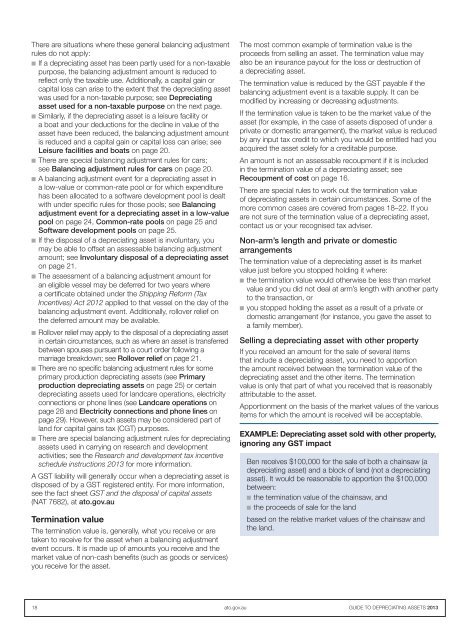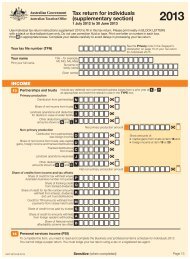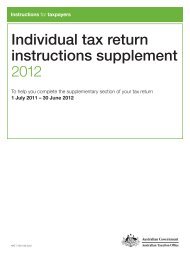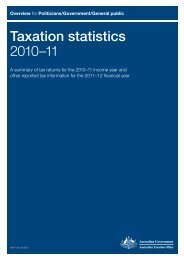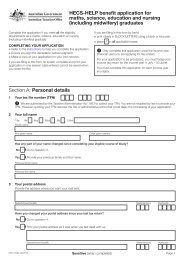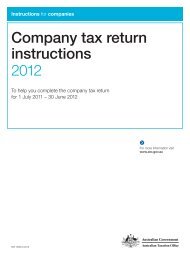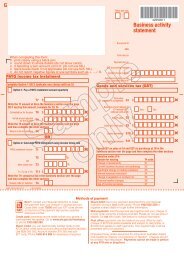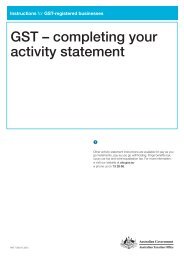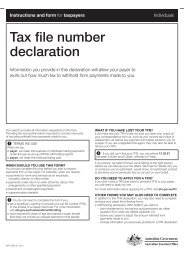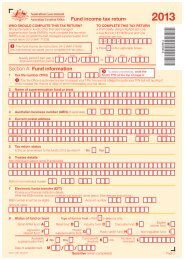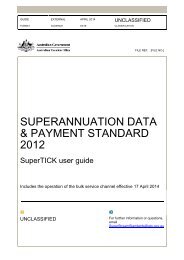Guide to depreciating assets 2013 - Australian Taxation Office
Guide to depreciating assets 2013 - Australian Taxation Office
Guide to depreciating assets 2013 - Australian Taxation Office
You also want an ePaper? Increase the reach of your titles
YUMPU automatically turns print PDFs into web optimized ePapers that Google loves.
There are situations where these general balancing adjustmentrules do not apply:n If a <strong>depreciating</strong> asset has been partly used for a non‐taxablepurpose, the balancing adjustment amount is reduced <strong>to</strong>reflect only the taxable use. Additionally, a capital gain orcapital loss can arise <strong>to</strong> the extent that the <strong>depreciating</strong> assetwas used for a non-taxable purpose; see Depreciatingasset used for a non-taxable purpose on the next page.n Similarly, if the <strong>depreciating</strong> asset is a leisure facility ora boat and your deductions for the decline in value of theasset have been reduced, the balancing adjustment amountis reduced and a capital gain or capital loss can arise; seeLeisure facilities and boats on page 20.n There are special balancing adjustment rules for cars;see Balancing adjustment rules for cars on page 20.n A balancing adjustment event for a <strong>depreciating</strong> asset ina low-value or common-rate pool or for which expenditurehas been allocated <strong>to</strong> a software development pool is dealtwith under specific rules for those pools; see Balancingadjustment event for a <strong>depreciating</strong> asset in a low-valuepool on page 24, Common-rate pools on page 25 andSoftware development pools on page 25.n If the disposal of a <strong>depreciating</strong> asset is involuntary, youmay be able <strong>to</strong> offset an assessable balancing adjustmentamount; see Involuntary disposal of a <strong>depreciating</strong> asse<strong>to</strong>n page 21.n The assessment of a balancing adjustment amount foran eligible vessel may be deferred for two years wherea certificate obtained under the Shipping Reform (TaxIncentives) Act 2012 applied <strong>to</strong> that vessel on the day of thebalancing adjustment event. Additionally, rollover relief onthe deferred amount may be available.n Rollover relief may apply <strong>to</strong> the disposal of a <strong>depreciating</strong> assetin certain circumstances, such as where an asset is transferredbetween spouses pursuant <strong>to</strong> a court order following amarriage breakdown; see Rollover relief on page 21.n There are no specific balancing adjustment rules for someprimary production <strong>depreciating</strong> <strong>assets</strong> (see Primaryproduction <strong>depreciating</strong> <strong>assets</strong> on page 25) or certain<strong>depreciating</strong> <strong>assets</strong> used for landcare operations, electricityconnections or phone lines (see Landcare operations onpage 28 and Electricity connections and phone lines onpage 29). However, such <strong>assets</strong> may be considered part ofland for capital gains tax (CGT) purposes.n There are special balancing adjustment rules for <strong>depreciating</strong><strong>assets</strong> used in carrying on research and developmentactivities; see the Research and development tax incentiveschedule instructions <strong>2013</strong> for more information.A GST liability will generally occur when a <strong>depreciating</strong> asset isdisposed of by a GST registered entity. For more information,see the fact sheet GST and the disposal of capital <strong>assets</strong>(NAT 7682), at a<strong>to</strong>.gov.auTermination valueThe termination value is, generally, what you receive or aretaken <strong>to</strong> receive for the asset when a balancing adjustmentevent occurs. It is made up of amounts you receive and themarket value of non-cash benefits (such as goods or services)you receive for the asset.The most common example of termination value is theproceeds from selling an asset. The termination value mayalso be an insurance payout for the loss or destruction ofa <strong>depreciating</strong> asset.The termination value is reduced by the GST payable if thebalancing adjustment event is a taxable supply. It can bemodified by increasing or decreasing adjustments.If the termination value is taken <strong>to</strong> be the market value of theasset (for example, in the case of <strong>assets</strong> disposed of under aprivate or domestic arrangement), the market value is reducedby any input tax credit <strong>to</strong> which you would be entitled had youacquired the asset solely for a creditable purpose.An amount is not an assessable recoupment if it is includedin the termination value of a <strong>depreciating</strong> asset; seeRecoupment of cost on page 16.There are special rules <strong>to</strong> work out the termination valueof <strong>depreciating</strong> <strong>assets</strong> in certain circumstances. Some of themore common cases are covered from pages 18–22. If youare not sure of the termination value of a <strong>depreciating</strong> asset,contact us or your recognised tax adviser.Non-arm’s length and private or domesticarrangementsThe termination value of a <strong>depreciating</strong> asset is its marketvalue just before you s<strong>to</strong>pped holding it where:n the termination value would otherwise be less than marketvalue and you did not deal at arm’s length with another party<strong>to</strong> the transaction, orn you s<strong>to</strong>pped holding the asset as a result of a private ordomestic arrangement (for instance, you gave the asset <strong>to</strong>a family member).Selling a <strong>depreciating</strong> asset with other propertyIf you received an amount for the sale of several itemsthat include a <strong>depreciating</strong> asset, you need <strong>to</strong> apportionthe amount received between the termination value of the<strong>depreciating</strong> asset and the other items. The terminationvalue is only that part of what you received that is reasonablyattributable <strong>to</strong> the asset.Apportionment on the basis of the market values of the variousitems for which the amount is received will be acceptable.EXAMPLE: Depreciating asset sold with other property,ignoring any GST impactBen receives $100,000 for the sale of both a chainsaw (a<strong>depreciating</strong> asset) and a block of land (not a <strong>depreciating</strong>asset). It would be reasonable <strong>to</strong> apportion the $100,000between:n the termination value of the chainsaw, andn the proceeds of sale for the landbased on the relative market values of the chainsaw andthe land.18 a<strong>to</strong>.gov.au GUIDE TO DEPRECIATING ASSETS <strong>2013</strong>


